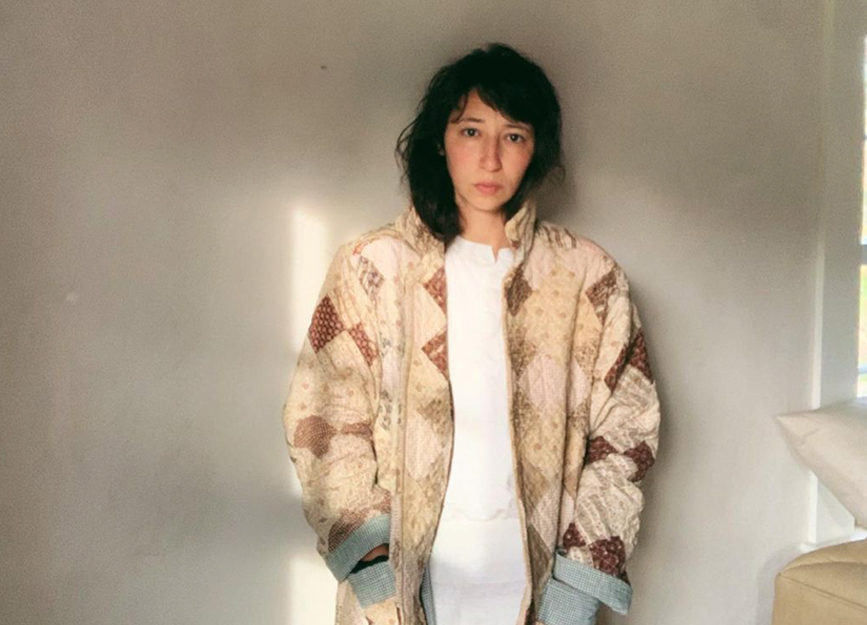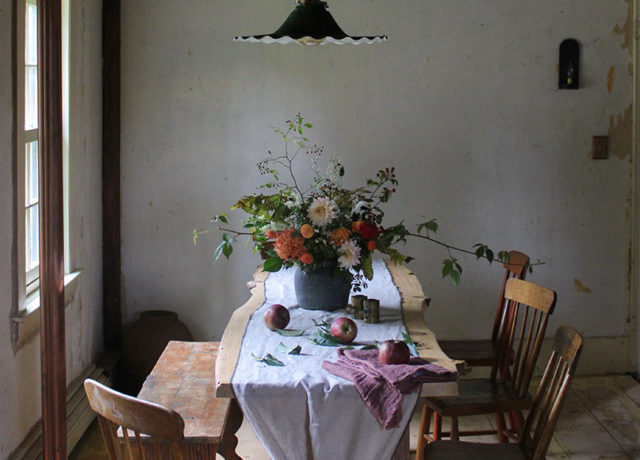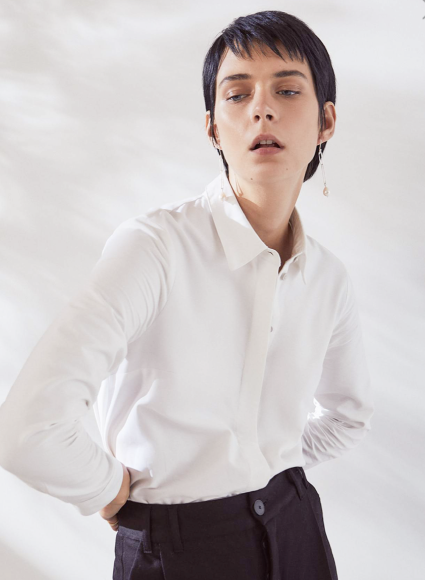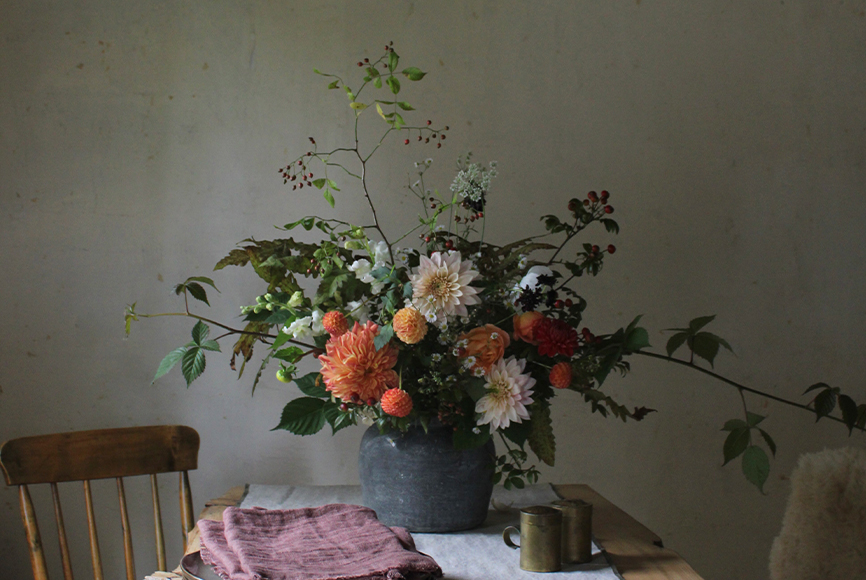
@besspier


Food & Garden
A Slow Living Lifestyle with Bess Piergrossi of Hitchfoot Farm
In this interview Bess Piergrossi describes her simple and poetic slow living lifestyle at her farmhouse in Maine. She shares with us her experiences running a farm. The lessons she learns from the animals that live there. And how she personally forages flowers to create beautiful arrangements in her workshop. She also expresses how to embrace a slow living lifestyle in the year of 2025.
“To love the things you surround yourself with. To admire them deeply, slowly, to take care of them, to keep things simple. I strive to have my house reflect the same feeling I get when I walk into that barn. I want my home to be a place where time stands still.”
Bess Piergrossi on the topic of a slow living lifestyle
Can you first of all tell us a bit about your connection to Maine? How did you end up in a farmhouse here?
I grew up bouncing around New England and the east coast. But after graduating from school on the New Hampshire Coast, I settled in Portsmouth New Hampshire. A rather touristy area, and moved across the river to Maine, in all honesty, in search of cheaper housing.
My husband and I had a dream of a simpler life. So we moved to Vermont to seek out a slower way of living. We only stayed one short year, though the lessons we learned about the way we wanted to live were invaluable. Learning to get our hands dirty in the soil. To watch the sunset. And we learned new passions, like farming and homesteading.
However, Vermont felt father away than we wanted to be from our family and friends. So we returned to Maine to try again. I got a job working early mornings at a local dairy farm down the road before going to work. Luckily, or call it fate if you will, the farmhouse on the dairy farm went up for sale a few years later, and I knew there was no other place I’d rather be.
What was your path to farming? Was it something instinctive or have you honed the way you engage with your farm through different life experiences?
I had no interest in farming in my younger years. I’d say I first was introduced to farming through food. I was a waitress, my (not yet) husband the Chef. He introduced me to every local farm he could— local cheeses, local meats, the best farm to buy tomatoes, arugula, or garlic, his favorite fisherman. Part of our pursuit to live in Vermont came from our desire to live closer to our favorite farms.
While our time in Vermont was short lived, I took a job as a farmhand the summer before we returned to Maine. The pay was low, the days were hot and long, but I was eager to get my hands dirty. From that moment on— there was a switch, from curiosity to instinct. I was doing what I was meant to do. My hands were meant to be in the soil. I ended each day biting into the juiciest tomato, visiting the pigs, often crouching in their pen, watching them give birth, pretending like my presence mattered in the experience.
When we moved back to Maine, I found a job working as a Production Manager on a Flower Farm— growing landscape annuals and perennials, as well as cut flowers for bouquets at the local market- something I had never done. I leaned into all of it, and was fascinated that creativity and farming could blend together so beautifully. Before the work day started, as I mentioned, I milked cows at the dairy farm down the street. Instead of ending the day checking on the pigs, I started my day singing to the cows. It was the dreamiest life I could ever imagine for myself, but an immense amount of physical labor, and long, long, hours.
The flower farm closed its doors, and my career shifted, so I fulfilled my dream to farm on our own property, making bouquets from our front flower gardens and selling them at a stand at the end of the driveway. It’s a different type of farming now, but with more freedom to express my creativity than I ever imagined— it’s my true pursuit of happiness.
What does your farm look like now? We hear there are some lovely chickens and cows there with you…
The dairy farmer who ran the dairy farm retired at 79 and sold his herd, but we still live in our beautiful farmhouse with a few of his “pet” cows in the back pasture. I miss milking deeply. We do have a wonderful flock of birds. I never knew I could/would love birds so much.
We have about 30 chickens give or take, I haven’t counted in a while, maybe 12 ducks, and 2 beautiful geese. They roam freely around the farm, living their best life. Looking out the window and watching them waddle around the yard feels like a fairytale. They add so much life to the property. We’ve expanded our flower operation just slightly, building a small greenhouse to start seedlings, and dedicated a small plot of our field to flowers. There’s no intention of expanding beyond this, at least for now, as the workload feels perfectly balanced at the moment.
Do you feel that engaging so much with the land and your animals helps you lead a more conscious and slow living lifestyle?
Definitely. The dairy farm was unlike any dairy farm you’d see today. It was an old farm- time stood still in that barn. I can’t say it any other way. It was/is my favorite place to be. Being with the cows, and with our own animals, has always had this effect on me. Time stands still. The life of scooping manure is a simple life- one I’ve sought after, and nothing gives me a greater reward. I think this translates into my aesthetic, how I find comfort in my surroundings. To love the things you surround yourself with— to admire them deeply, slowly, to take care of them, to keep things simple. I strive to have my house reflect the same feeling I get when I walk into that barn. I want my home to be a place where time stands still.
What have you learned from the animals you live with?
Our three cats teach me to be present, and how to love fully. How to be in the moment. But farm animals, the pigs, chickens, ducks, and cows have been my greatest teachers. Working on a farm, life and death is a weekly occurrence. There’s repetition to the way Mother Nature works. It’s taught me more about what it means to be alive, to feel pain, to suffer, to celebrate, than any human ever has. Watching animals survive and thrive through these experiences, so routinely, has taught me about strength, resilience, and instinct, and has unleashed a truth about life that I wasn’t aware existed.
“Flower farming is one of the most tender, sacred relationships I have. The amount of love put into the preparation of the soil, into the planting of the seed, into the watering and weeding, to then be rewarded with a beautiful gift.”
Bess Piergrossi on the topic of a slow living lifestyle
You also showcase the most beautiful floral arrangements. What about your personal connection flowers? How did your creative spirit with these evolve?
I’ve always loved art – drawing, painting, playing with color. Flower farming is one of the most tender, sacred relationships I have. The amount of love put into the preparation of the soil, into the planting of the seed, into the watering and weeding, to then be rewarded with a beautiful gift. I find flowers on their own exquisite, but this combination of hard work and beauty transport me to all sorts of places when it comes to floral arrangements. I like to think of flowers as my painters palette— the opportunities to create art are endless.
Where do you get your flowers from and if you forage them yourself, how do you use that process to connect to nature?
I grow them all or forage for them- I’ve never been to a flower market, though I would like to some day. I find it hard to put a price tag on flowers— as for me they are a labor of love- a reward for our hard work and passionate pursuit. Would I buy a wholesale tulip for a few dollars to add into an arrangement? Maybe— but that’s really not the point. My arrangements are forms of celebration of the present moment. I’m less concerned with supplementing, which is mostly why I find “organized” floral jobs like weddings or CSA’s rather difficult for a farm of my size. I’d rather live spontaneously through the flowers, showcasing them only when they are ready.
Can you tell us why seasonality and keeping things local is so important when it comes to flowers?
For all the reasons mentioned above— but on top of that, the international flower market is…. depressing and a major cause of climate change. If you only knew the life of a rose at the grocery store. I prefer to celebrate what’s blooming in the moment. It helps you appreciate what you have, when you have it. Would I love tulips as much as I do if they bloomed year round? No. Would a lilac still smell so heavenly if it bloomed all season? No, probably not. One of the best parts of flower farming locally is the wave of colors, scents, shapes that blooms from April until October, with almost every week having something new to offer, a new flower to relish. That’s my favorite part.
You have such a beautiful home – how have you spent your time with it’s evolution?
It’s been a long journey, although we’ve only been here three years, so in that lens, no time at all. When we first bought the house it had amazing bones, and we luckily only needed to partake in cosmetic updates. The home was painted in period colors, wallpaper in several rooms, and felt very adorned. Our vision was to strip it back to the basics, to how it would have looked as if it was freshly built in 1740. This has been a lot of work, striping wallpaper, scraping floors, sanding mantles, plastering walls, but it’s been so refreshing to breath new life back into this space, and to honor it exactly how it is, at each phase of the process, peeling paint and all.
How do you source most of the items you include in your home?
I can confidently say I think 95% of our belongings are second hand, or antique. Antiquing is a passion for my husband and I… we’re always on the hunt for something that catches our eye. Rarely do we say “We need a side table” and buy one. We wait until we see a piece that strikes our fancy. In the meantime, we’ll use a stool or do without.
We moved into the house from a 300 sq foot apt, so we had the opportunity to truly curate what we brought into our new home. We live pretty minimally. Our goal has never been to furnish the home, but to just surround ourselves with things that we love first and foremost.
I’m drawn specifically to things that have seen a lot of wear and tear— utilitarian things, not decorations. Tables—knives— spatulas— light fixtures. I love patina. Scratch marks. Dents. I get a lot of joy out of continuing to love these items.
You have done a few posts on natural dyeing. How have you found this process of working with plant based colors and creating things yourself?
Just trial and error— I can’t recollect when I was first introduced to this, but for me its just another way to express my creativity— something new to try. There’s never a goal, or expected end result— there really can’t be with natural dyes. I mostly enjoy just dying scraps and old rags, giving an old dish cloth new life for a few more washes. It’s just all for fun.I’d love to dye larger scrapes, enough to sew something out of someday, but for now I’ve just stuck to my small kitchen pots and pans to make the magic happen. It’s much easier to manage for a beginner like me.
As we enter 2022 with a hope that people will begin to embrace slower ways of living, can you give us all one tip for how to embrace a slower style of life?
Surround yourself with things you love. Yes, people and animals are great, but also tangible things. Flowers. Hand Knit Socks. Berries. A vintage coffee mug. Challenge yourself to learn what you love. Pursue it – whether it’s big or small. Is it easier to buy a new can opener off Amazon? Yes. But for the same price, if not cheaper, you can find one that you actually love, maybe at your local antique shop, or on Etsy.
Every time I use my can opener I smile. It takes patience, letting go of instant gratification, and a sense of curiosity, but it makes my every day much more interesting. At least for me. For Now. Maybe this patience will run out as we welcome a new child in this new year, but I hope not.
I hope this is a lesson I can pass down to her. To surround herself with the things that make her happy. Apple pie. A bath with flower petals. A woven blanket. A hug. The lick of a cow’s tongue. Whatever it may be— to indulge in those small moments.
A Slow Living Lifestyle. Words from Bess Piergrossi @besspier
































